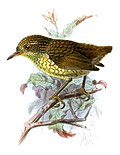Distribution and habitat
The purple-throated fruitcrow has a disjunct distribution. One population is found in Central America from southeastern Nicaragua south along the Caribbean side of Costa Rica and Panama and also on the Pacific side of Panama from the Canal Zone south. Its range continues across north-central Colombia and the valleys of the Cauca and Magdalena rivers and south along the western slope of the Andes through Colombia into northwestern Ecuador as far as northern Los Ríos Province and spottily beyond. [5] [6] [7] A second population is found from southeastern Venezuela east through the Guianas and extreme northern Brazil to the Atlantic in Amapá state. That range continues south in eastern Brazil to western Maranhão and Tocantins and from there west across southern Amazonian Brazil to the Andes in southeastern Colombia, eastern Ecuador, eastern Peru, and northern Bolivia. According to some sources it skirts a wide band of northern Amazonia. [1] [5] However, van Perlo's field guide shows the species occupying the entirety of the Amazon Basin. [8]
The purple-throated fruitcrow inhabits lowland evergreen forest in the tropical zone, where it prefers the forest's midstory to canopy. [5] [9] In elevation it ranges from sea level to 500 m (1,600 ft) in Costa Rica and 1,400 m (4,600 ft) in Colombia, mostly below 500 m (1,600 ft) on both sides of Ecuador, up to 1,000 m (3,300 ft) in Peru, up to 500 m (1,600 ft) in Venezuela, and from sea level to 750 m (2,500 ft) in Brazil. [10] [6] [7] [11] [12] [8]
Behavior
Movement
The purple-throated fruitcrow is a year-round resident. [5]
Feeding
The purple-throated fruitcrow feeds primarily on fruit; adults also feed on large insects and feed nestlings mostly insects. The species typically forages in small groups (up to eight individuals) that usually stay to themselves but sometimes mix with other large species. They feed mostly in the forest's midstory to the canopy and take most fruit and insects with short sallies from a perch. Some fruits are taken while perched. They tend to regurgitate fruit seeds away from where they eat, "providing an effective method of seed dispersal for the plants it feeds on". [5]
Breeding
The purple-throated fruitcrow breeds mostly in the local wet season, including July and October in Panama, March and June in Colombia, March in Venezuela, and February and April in the Guianas. Males make what is thought to be a courtship display by spreading their throat shield and shivering their tail. The species' nest is a cup or platform made from sticks lined with very fine twigs. It typically is placed in a branch fork between about 11 and 23 m (35 and 75 ft) above the ground. Both sexes build the nest. The clutch is one dark olive egg. Incubation takes about 25 days and fledging occurs 32 to 33 days after hatch. Both sexes provision nestlings. The species is a cooperative breeder and unrelated adults contribute to the provisioning. The social groups also contribute to defending the nest from predators. [5]
 | Songs and calls
|
Vocal and non-vocal sounds
The purple-throated fruitcrow has a wide variety of vocalizations. Its songs have been described as "a mellow, mewing, falling-rising COW-uh?" and "a rising ohhahhh?", and its call as "a raspy coughing or 'throat-clearing' sound". [11] Other calls are described as "a drawn-out ooo-waáh or kwih-oo, ooo-waáh" and in flight a "wah-wah-wheéeawoo". [7] Nearby observers can sometimes hear wingbeats. [5]
This page is based on this
Wikipedia article Text is available under the
CC BY-SA 4.0 license; additional terms may apply.
Images, videos and audio are available under their respective licenses.




